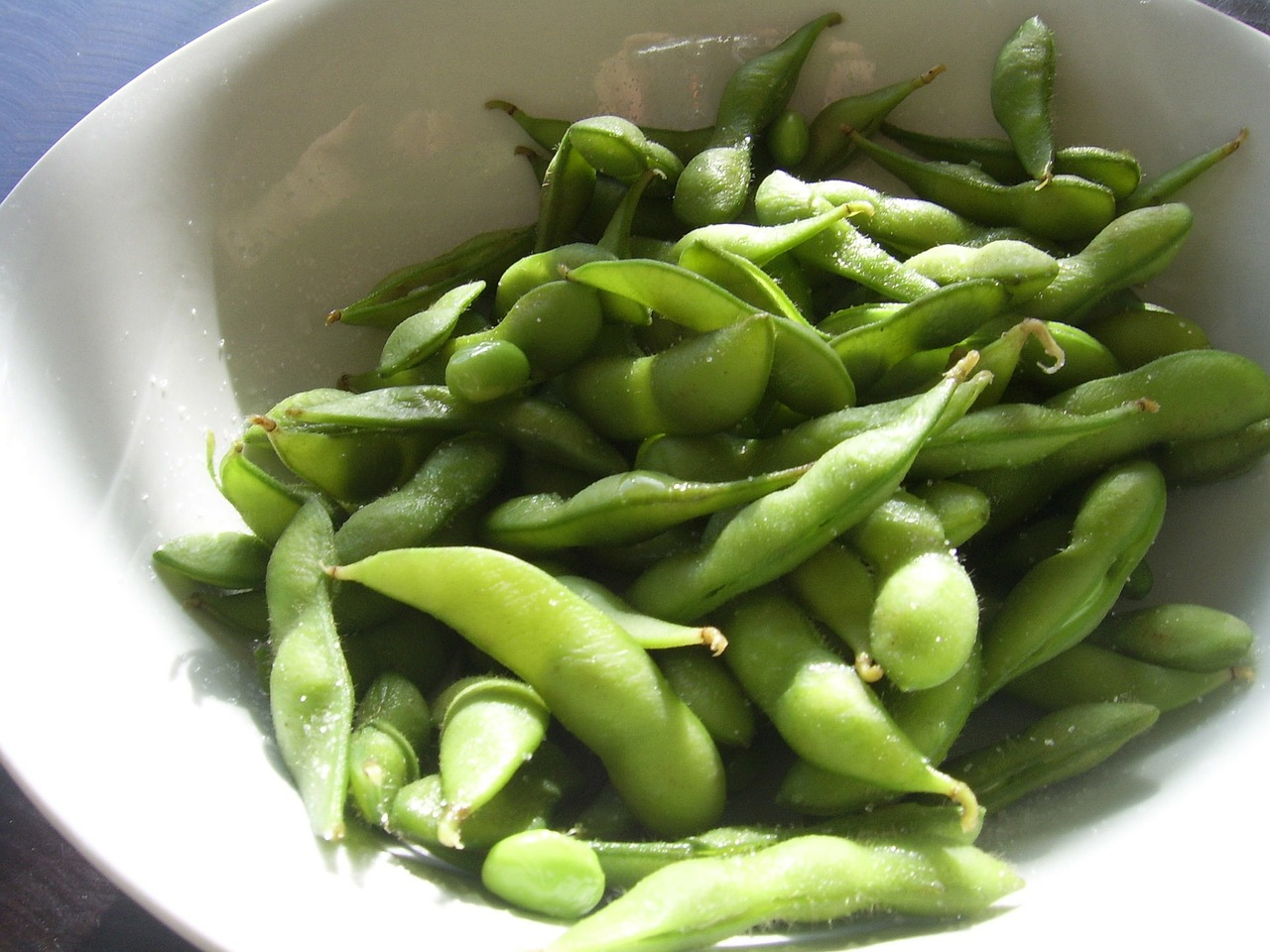Every time my husband and I go out for sushi (once in a blue moon!) we have to order a bowl of delicious, steamy, salty edamame.
It’s a must. Sushi just does not taste the same without an edamame appetizer.
So, you can imagine how excited I am to learn how to grow edamame myself, and be able to enjoy those tasty morsels more than once or twice a year!
Better yet, it’s amazing to be able to educate our customers on the health benefits of soy and let them enjoy these tasty bites for themselves.
Now, since I am not an edamame growing expert (yet!) we will be learning from Pam Dawling, author of Sustainable Market Farming, and her experience growing and selling edamame.
About Edamame
Edamame is an interesting, high protein, fast-growing, easy-care, warm weather crop.
Edamame is the name for varieties of soybean that are eaten as a fresh vegetable or snack food like roasted peanuts.
There is a huge potential market for edamame, which appeals both to those seeking local fresh produce and to those appreciating the benefits of soy.
Most small-scale growers sell them as pods or as bunched plants.
Edamame variety differs from field soybeans in being larger, milder, sweeter, tender, and more easily digested.
Varieties of Edamame
There are a couple of varieties of edamame, open-pollinated (OP) and hybrid.
However, it should be noted that seed catalogs do not always make it clear which variety they are selling.
Varieties available commercially include:
- Beer Friend (OP): 85 days to maturity (DTM)
- Besweet 292: 85 DTM
- Black Jet: 104 DTM
- Black Pearl (OP): 90DTM
- Butterbeans (OP): 90 DTM
- Davis Family Blend: 75 DTM
- Early Hakucho
- Envy: 75 DTM
- Kouri: 85 DTM
- Lucky Lion: 75 DTM
- Misono Green (OP): 85 DTM
- Sayamusume (OP): 85 DTM
- Shirofumi (OP): 90 DTM
- Tamba Kuro Otsubu: 150 DTM
- Tankuro: 85 DTM
- White Lion: 75 DTM
Crop Requirements
Edamame will grow in wet or dry weather and in varying soil conditions, so long as it has warm weather.
The pods of most varieties are ready for harvest, though some black seeded ones take up to 150 days.
All the pods are usually picked in a single harvest, making this an ideal crop to grow in succession, sowing several times during the growing season.
In cooler climates, edamame can take considerably longer to reach maturity than the catalog suggest.
All soybeans, including edamame, are ranked in maturity groups with 0 being the fastest maturing (70 to 90 days) and 8 the slowest of the groups suitable for the mainland USA.
All the varieties except for the earliest maturing ones are also sensitive to day length, meaning that they will not shift from the vegetative (leafy) stage to the productive (flowering) phase until the length of daylight falls below a critical level.
Northern growers with long summer days should probably stick to groups 0 and 1, even with a hoop house to boost production by raising temperatures, and add 25 to 40 days to the days to maturity listed in seed catalogs.
Where the seasons are long enough, edamame can also be grown as a summer “catch crop” on a bed following a spring crop, and before a fall crop.
Maintain sufficient organic matter in the soil, supply ample moisture, and don’t miss the harvest window.
A benefit of growing edamame is the nitrogen that the root nodule bacteria adds to the soil.
A following crop of greens will probably do well.
Note that soybeans are only a moderate nitrogen fixer compared to alfalfa.
Sowing Edamame
Make the first sowing in a sunny location, just after the average last frost date.
The ideal soil temperature is above 55°F (13°C), with air temperatures around 68°F (20°C).
Soil pH of 6 to 6.5 is best.
Sow 1” to 1.5” deep with about 2-3” between seeds and 6-24” between rows.
If you have not had many soybeans growing on your land in the past, use soybean inoculant, which is not the same as general-purpose pea and bean inoculant.
Germination is usually rapid, within two weeks, and the bushy plants will out-compete weeds after initial cultivation.
Outdoor sowings can continue every two weeks until about 90 days before the average first frost date, depending on the variety chosen.
Sowing varieties with different growth periods on a single sowing date can also provide a long harvest season.
Edamame may also be transplanted, which makes growing the crop possible in areas with a shorter season.
Pests and Diseases
Edamame is relatively pest-free.
However, Japanese beetles can be a problem.
The best hope is the parasitic spring Typhia wasp.
Grow Forsythia to entice Typhia wasps down from the tree canopy to bean level, especially if you have tulip poplar trees, a favourite of the wasps.
Rabbits, groundhogs, deer, and elk can also bring trouble.
Bird netting and row covering may protect young plants against smaller mammals.

Harvesting Edamame
Pods are ready when the beans are big and lumpy, almost touching within the pod, and the hairy pods are just changing from bright green to golden.
The exact colour does seem to vary between varieties, and it is somewhat a matter of personal taste.
As the beans age, the flavour becomes more starchy, less sweet, and less nutty so don’t wait too long to harvest!
The pods generally mature at the same time, so a single harvest is the most efficient method.
If you have too many to pick at once, try harvesting the bushes two or three times a few days apart.
Because edamame is a legume, you may want to clip the stems above the soil level and leave the roots with the nitrogen-fixing bacteria in the soil.
It is quicker to pull up the plants, but less nitrogen will remain in the soil.
Post-harvest Storage
Edamame is not easily stored in pods for long. They need cool conditions with some airflow to prevent mold from growing.
One method of storage is to wash, drain, and ice the beans before refrigerated storage in mesh bags.
Alternatively, when pods are left on the pulled plants, the flavour can be retained for several days.
Cooking Edamame
Since edamame is an unusual vegetable, it’s good to provide your customers with some instructions on how to cook it.
Here is a deliciously simple recipe:
- Boil the pods in salted water for 6 to 8 minutes then drain and serve.
- I also like to toss them in some salt while they are in the bowl before I eat them.
- Then simply pop the beans out of the shell with your mouth or fingers.
- Enjoy!
Season Extension
Edamame can be grown in a hoophouse later than outdoors.
This can be a good way to use the covered space in late summer before fall greens are planted, and it also helps by providing a rotation away from nightshades, lettuce, spinach, and brassicas.
Bottom Line
Edamame is surely a unique crop that will most likely attract some new customers to your market stand.
Whether they are a good fit for your market farm depends on your climate and customer base.
I would like to give this crop a try next year, as we already have our crop plan for the 2021 season and have not included edamame.
Do you grow edamame? If so, please tell us about your experience in the comments below.
Stay Local,
Kathy & Jon
your friendly neighbourhood growers


0 Comments